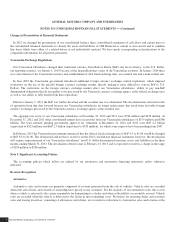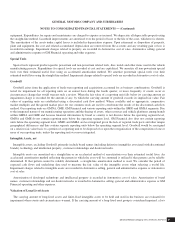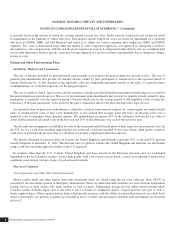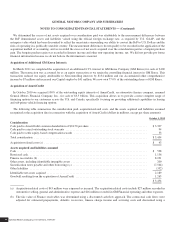General Motors 2012 Annual Report Download - page 89
Download and view the complete annual report
Please find page 89 of the 2012 General Motors annual report below. You can navigate through the pages in the report by either clicking on the pages listed below, or by using the keyword search tool below to find specific information within the annual report.
GENERAL MOTORS COMPANY AND SUBSIDIARIES
NOTES TO CONSOLIDATED FINANCIAL STATEMENTS — (Continued)
• Historical experience with tax attributes expiring unused; and
• Near- and medium-term financial outlook.
It is difficult to conclude a valuation allowance is not required when there is significant objective and verifiable negative evidence,
such as cumulative losses in recent years. We utilize a rolling three years of actual and current year anticipated results as the primary
measure of cumulative losses in recent years.
Income tax expense (benefit) for the year is allocated between continuing operations and other categories of income such as
Discontinued operations or Other comprehensive income (loss). In periods in which there is a pre-tax loss from continuing operations
and pre-tax income in another income category, the tax benefit allocated to continuing operations is determined by taking into account
the pre-tax income of other categories.
We record uncertain tax positions on the basis of a two-step process whereby: (1) we determine whether it is more likely than not
that the tax positions will be sustained based on the technical merits of the position; and (2) for those tax positions that meet the more
likely than not recognition, we recognize the largest amount of tax benefit that is greater than 50% likely to be realized upon ultimate
settlement with the related tax authority.
We record interest and penalties on uncertain tax positions in Income tax expense (benefit).
Derivative Instruments
We are party to a variety of foreign currency exchange rate, commodity, interest rate swap and interest rate cap derivative contracts
entered into in connection with the management of exposure to fluctuations in certain foreign currency exchange rates, commodity
prices and interest rates.
In connection with certain long-term supply contracts that we have entered into, we have identified embedded derivatives which we
have bifurcated for valuation and accounting purposes.
GM Financial is exposed to market risks arising from adverse changes in interest rates due to floating interest rate exposure on its
credit facilities and on certain securitization notes payable. GM Financial’s special purpose entities (SPEs) are contractually required
to purchase derivative instruments as credit enhancements in connection with securitization transactions and credit facilities. These
financial exposures and contractual requirements are managed in accordance with corporate policies and procedures and a risk
management control system is used to assist in monitoring hedging programs, derivative positions and hedging strategies. Hedging
documentation includes hedging objectives, practices and procedures and the related accounting treatment.
The accounting for changes in the fair value of each derivative financial instrument depends on whether it has been designated and
qualifies as an accounting hedge, as well as the type of hedging relationship identified. Derivative financial instruments entered into
by our automotive operations are not designated in hedging relationships. Certain of the derivatives entered into by GM Financial
have been designated in cash flow hedging relationships. Derivatives that receive hedge accounting treatment are evaluated for
effectiveness at the time they are designated as well as throughout the hedging period. We do not hold derivative financial instruments
for speculative purposes.
All derivatives are recorded at fair value and presented gross in the consolidated balance sheets. Internal models are used to value a
majority of derivatives. The models use, as their basis, readily observable market inputs, such as time value, forward interest rates,
volatility factors and current and forward market prices for foreign currency exchange rates and commodities. We estimate our
nonperformance risk using our corporate credit rating, the rating on our secured revolver, and yields on traded bonds of companies
with comparable credit ratings and risk profiles. Derivative contracts that are valued based upon models with significant unobservable
market inputs, primarily price, are classified in Level 3.
General Motors Company 2012 ANNUAL REPORT86
























